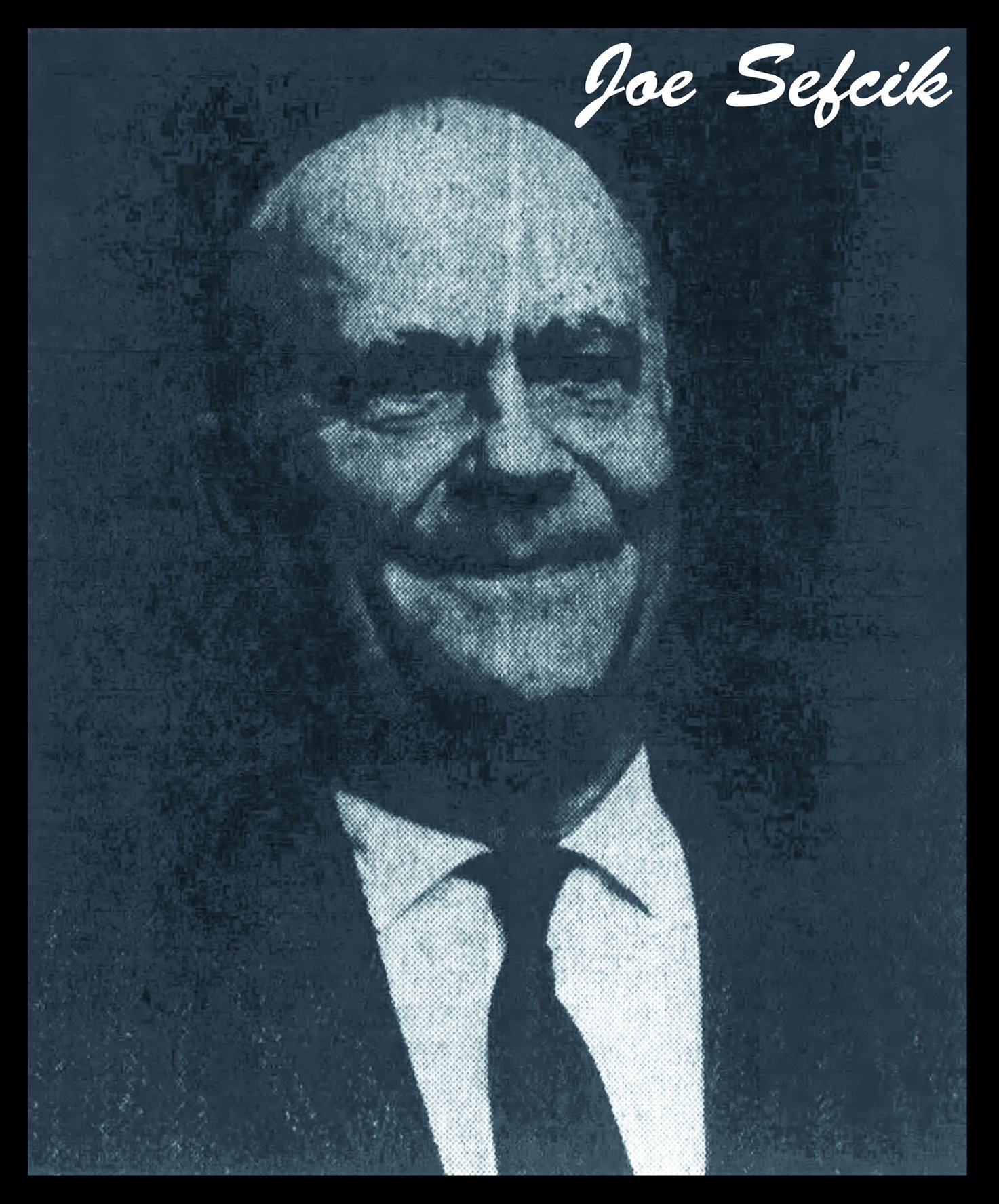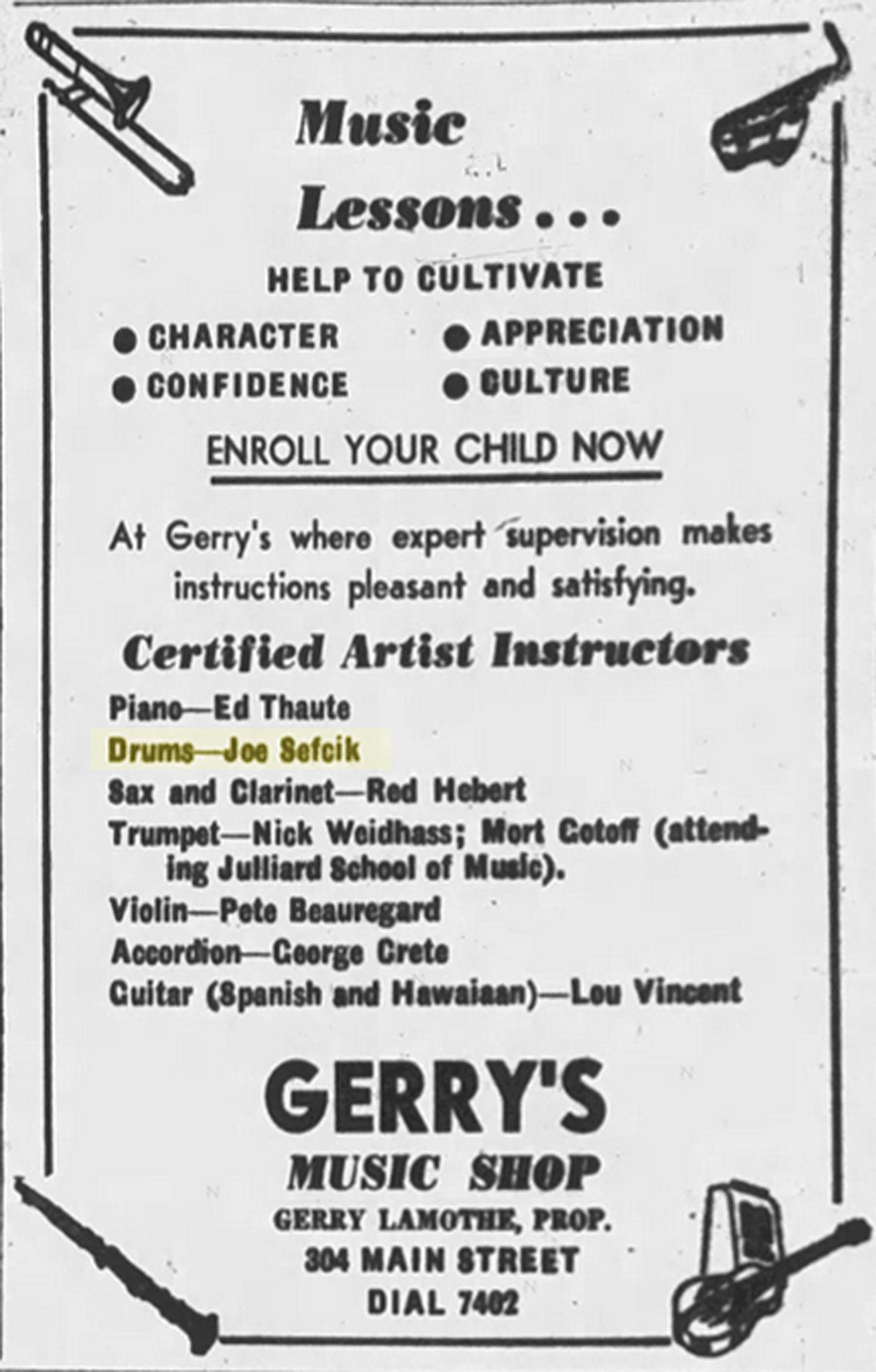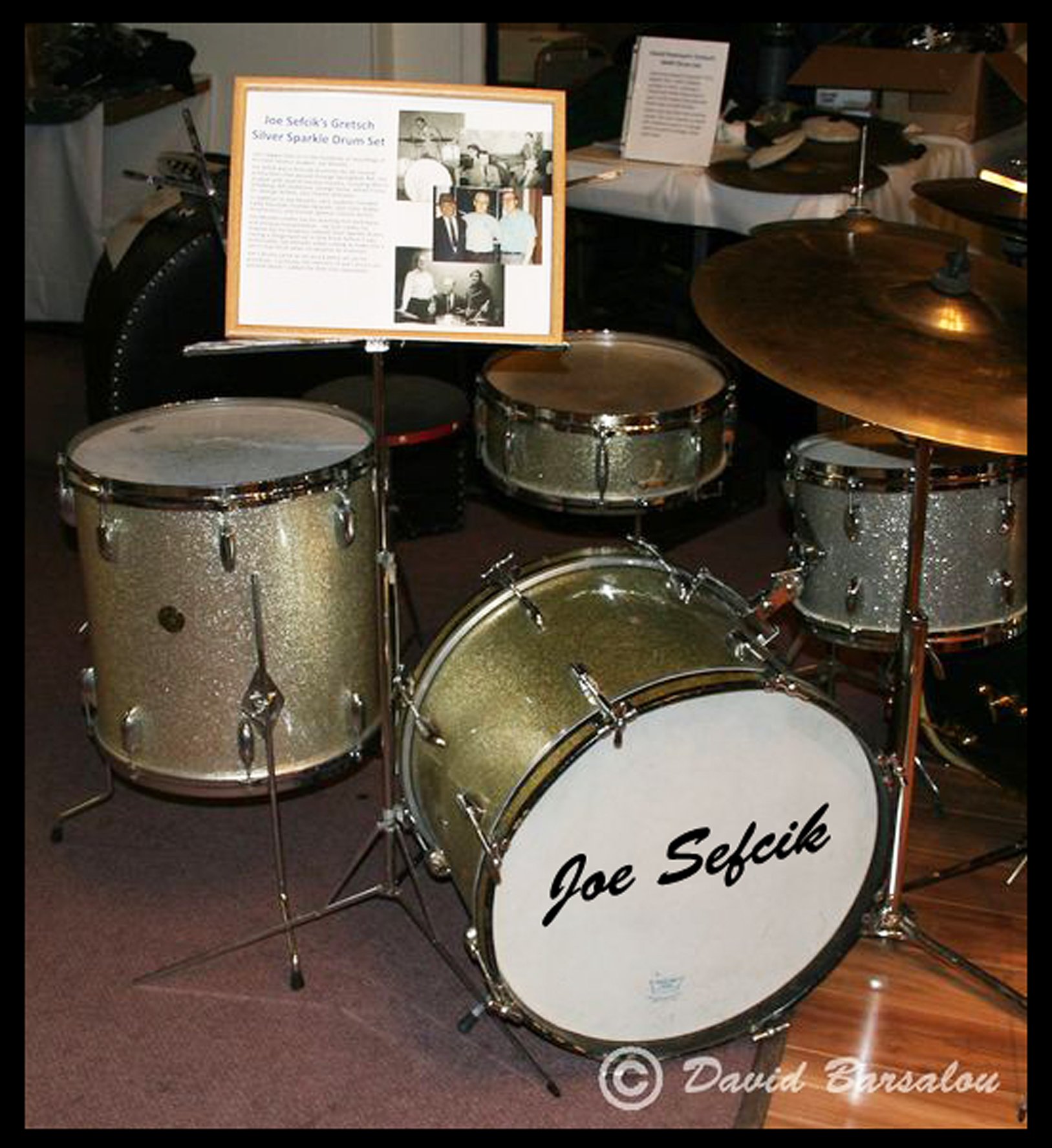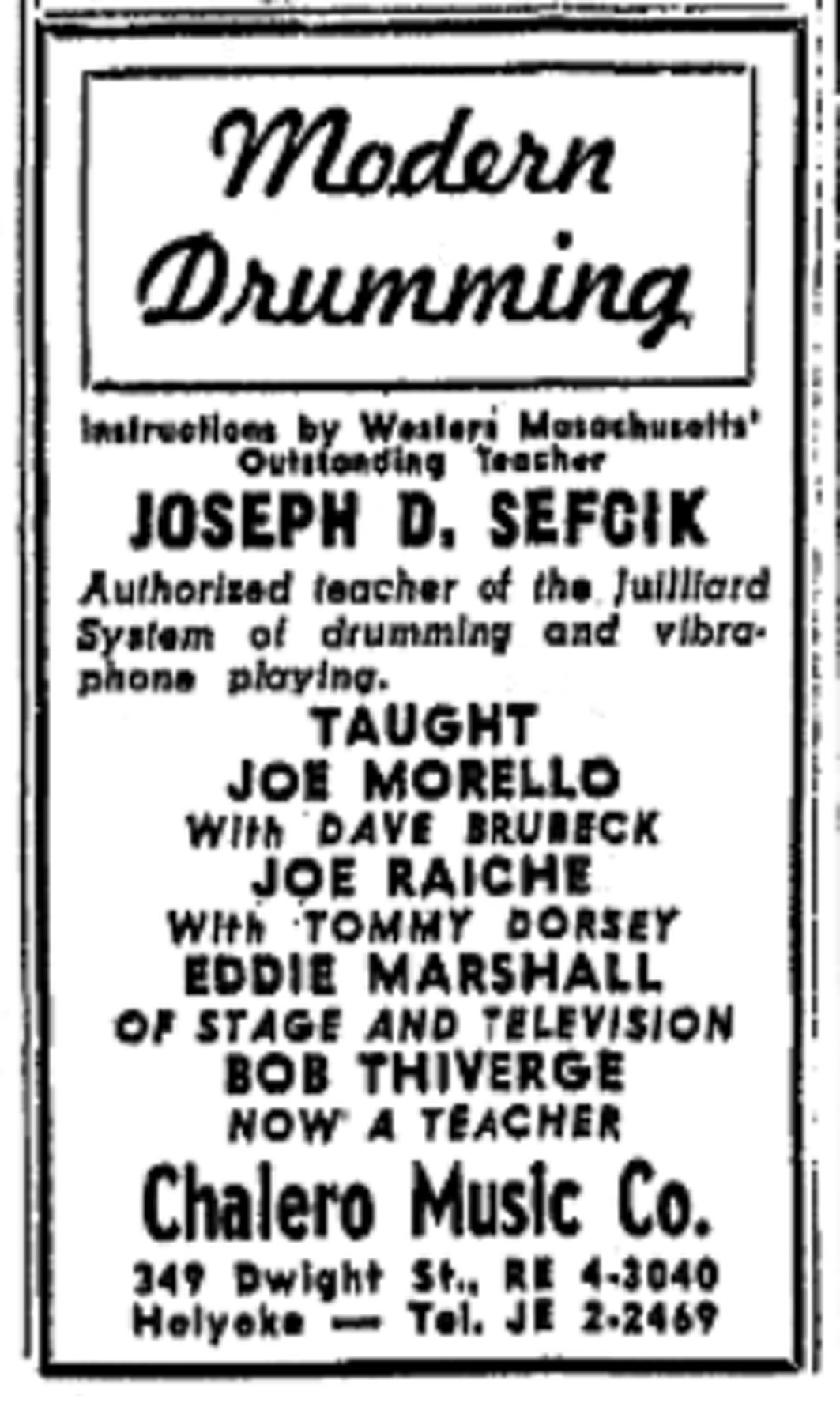More Recollections Of Joe Sefcik By His Former Students: Michael Hotte, Richard Madej, Steven McMahon, Edward Mierzewski, Rick Shlosser, and John Sroka



Joe Sefcik was always smoking a cigar. Someone from the neighborhood asked me to hold a set of drums for him - I said yes and put them in my bedroom. Meanwhile, I had heard that Joe’s drums had been stolen. Well, I noticed the drums in my room smelled just like cigars, so I told my dad -- I think these might belong to Joe. My dad called him… He came over to my house and sure enough they were his drums. We helped put them in his car and he was very grateful. I was so happy that he got his drums back.
I was about 14 years old when I began studying with Joe Sefcik. I remember that he had these heavy lead sticks he would have me practice with. When I went back to using regular sticks, they felt so light. Joe would say to me, “when your friends go out to play baseball, tell them you need to practice -- stay home and practice your lesson, that's what you need to do if you want to be a drummer”. In his studio, Joe had all of these rigged up pads with rubber on the cymbals, and hi hats, it looked all home made but was so cool. I remember him teaching me the pattern to a Beatles song with an easy swing on the cymbal.
I was young and don't think I really appreciated what he was teaching me at the time. But he did teach me a lot that I still use today -- like ‘always count time’. I’m older now but still do that to this day. Good Ol’ Joe. I miss him.
-- Michael Hotte
As a twelve year old kid, showing up at Joe Sefcik’s studio was a pretty intimidating experience. My dad drove me to Holyoke, Mass. from nearby Chicopee… We soon found the Victory Theater building… Joe was located just upstairs from the Pizzitola Music Studios.
My first emotions were of fear and anxiety since this experience was a bit out of my normal “kid experience.” I remember going into the room and being somewhat underwhelmed by the drum equipment, mainly the age of the stuff. Joe handed me some sticks that were, what I thought, way too big for my small hands. I was all of five foot two and a lightweight. I sat down behind the drums. Joe gave me the Bower system drum book and then dove right in.
After a few lessons I realized that this was not going to be an easy ride since Joe was not someone that would let you get away with not practicing or being unprepared…He was certainly not shy about letting you know you were a slacker.
Another unforgettable part was other students sat in the room during your lesson. I think the idea was to subtly show what good form versus bad was. It was easy to tell based on the amount of criticism or praise Joe was providing. And, oh yeah, by then I was accustomed to the cigar smoke.
After a few months, out of the blue, Joe said that I needed to talk to the guitar teacher next door, Bob Ezold, because he may have an opportunity for me to start playing in a band. Typical of Joe, there were not many details. To me, it was Joe’s way of saying, “Hey kid you’re doing fine, and you can handle this.” The band turned into the Bristol Curries experience but that’s a story for another time.
Now for the technical stuff… Joe’s method of teaching suited me well… Although I may not have not known it at the time. He was able to expose his students to many genres of music even if you were only interested in Rock & Roll. The material he gave to his students, written in our music notebooks, was gold - things that a professional drummer lived with throughout their career. In retrospect, it was probably the best thing he could have given us. I regret that I don’t have that notebook anymore. I also know, now, that his insisting on his students learning to read music was invaluable.
His depth of knowledge was vast, and I remember one tidbit he told me about playing in a band and getting paid. His advice to me was, “dress nice, show up on time, and keep the beat steady. No one goes to a show and pays money to watch the drummer show off.”
Joe came to see the Curries play once when we had a gig in Holyoke. After it was over, he came up and said to me “good job”. He shook my hand and walked away. I still get misty eyed to this day thinking about it. ‘Affirmation from The Man’.
Joe taught me the love of all music, Jazz, Big Band, Latin, and the love has not left me. The hands are a bit arthritic, but I still manage to “keep the beat steady.”
“-- Richard Madej
I started taking lessons with Jimmy Calipilito at the age of 8. It was sticks only on a little drum pad. He taught me the rudiments and marching drum beats. After a while, he said I was at the level where I should seek out someone who teaches drum set – which had always been my desire. I acquired a basic kit and my brother Don McMahon drummer gave me a few lessons. After that at the age of twelve I began studying with Joe Sefcik at Chalero's Music store on Chestnut Street in Springfield, MA. Joe used to take the bus down from nearby Holyoke and teach every Tuesday. With his fedora and coat, Joe looked like he was right out of the Al Capone era. His drum kit there consisted of wood with some pieces of glued on rubber and a couple of banged up cymbals but everything served its purpose. Of course, he taught traditional grip. I could not believe just how much my left wrist had to twist to get that stick up beyond the vertical to satisfy him... But eventually I got it.
He once told me that I had good hands, which I considered to be a great compliment. This did not mean that you could now bluff your way through a lesson. If a student didn't practice enough, he knew it. Early on in my studies Joe asked me why I was wasting my parent’s money… He never had to say that again. I stopped taking lessons at 14 when I began playing in a wedding band, and also with my brother’s group when he needed a fill in. At 16, I went to see if Joe was still teaching at Chalero’s. You can imagine my delight when I found that he was back after taking a year’s hiatus to study with Joe Morello in New York.
He charged me $4.00 instead of $5.00 because "I was an old student" of his. I remember him talking not only of Joe Morello, but also Alan Dawson and Ed Shaughnessy, among many others.
He would always share new rhythms with his students that he acquired through his vast network. I studied for another seven months until I found out that Joe had passed away at 72.
Mr. Chalero told me that it was Joe's birthday party and someone goaded him to get up and play when he was not feeling well and that’s when he suffered a heart attack. I don’t really blame someone for wanting to hear Joe play but they shouldn’t have pressed him. Hindsight is always 20/20. At that time, I was really enjoying being back with Joe, and still wonder where I might have ended up had I been given the opportunity to continue my studies.
I'm still drumming at the age of 70 and have also studied congas with Brandon Marger and Bodhran with Michelle Stewart… I miss Joe and will always fondly remember my Tuesday lessons down in the basement of Chalero’s Music.
I respected and admired him as a teacher and a person - feeling very honored to have been one of his students. I remember something that Joe once shared with me. - It goes like this: "Into each life some jazz must fall with after beats gone kicking, with jive alive a ball for all, let not the beat be chicken".
-- Steven McMahon
Some thoughts on Joe Sefcik… I started drums with Joe in 5th grade and all through high school and even during my years at Berklee College of Music. These were happy times as I really loved learning and playing. My album collection reflected many talented drummers while Joe would always relate stories about other greats.
Joe was quite the musician in his time, but never talked about it - or the fact that he was the house drummer at the Valley Arena in Holyoke Mass, supporting numerous traveling groups when they came to town.
Because Joe taught me to count it out, I never had trouble figuring out rhythms. He would say, “If you can count it, you can play it.”
Joe played an important role in my educational direction. My great admiration for him inspired me to pursue percussion at The Hartt School of Music in West Hartford, CT and at Berklee.
After graduation, I became a public school music teacher and also taught privately. Just as Joe was a great teacher and mentor, my years in the classroom have been rewarding in that I have had great students that went on to study Music and pursue a career. I had the now principal trumpet of the Springfield Mass. Symphony in 5th grade. (Tommy Bergeron)
Thank you, Joe.
-- Edward Mierzewski
As for Joe Sefcik, he was a bit intimidating if you hadn't practiced when you showed up for your lesson! You could feel his disappointment, but then he would show lots of patience, as any good teacher would, and get you back on track!
Between Joe and Bill McCullough, his pupil for years before I was taking lessons, I learned so much! I'm eternally grateful!
-- Rick Schlosser
Before I studied with Joe Sefcik I took lessons from Norman Bail and Robert Thivierge, two of Joe’s former students. I was playing and teaching full time and thought Mr. Sefcik could be helpful to me in both areas. He turned out to be more than helpful - he was a fountain of drumming and percussion knowledge.
We worked on the Moeller Method, George Stones’ level system, Billy Gladstone techniques and developing finger control. Joe would help me refine these techniques over the next three years I studied with him. Other books he considered important were the Bower Method, Anthony Cirone’s Portraits in Rhythm (a heavy concentration on dynamics and metronome markings), Ted Reed’s Syncopation book, Stick Control, Accents and Rebounds, The Buddy Rich Book, Charley Wilcoxon’s The All-American Drummer, Modern Rudimental Swing Solos for the Advanced Drummer and Jim Chapin’s Advanced Techniques for the Modern Drummer.
Joe’s general instructions were to always play new material slowly -- avoiding mistakes and then gradually increase speed using a metronome. Play rudiments and hard phrases using the “Time Table” which was basically; quarter notes, eighth notes, triplets, sixteenth notes. etc.
Play in front of a mirror to observe your hand positions and motions and ALWAYS count out loud. Joe had various ways to use the books. We went through each book as written and then used them with some novel ideas:
1. Stick Control, for pages 1 to 7 a play the Lefts with left hand and Rights as bass drum against a Jazz ride beat, shuffle beat and straight eighth rock beat.
2. Ted Reeds Syncopation, The Syncopation Studies section play eighth notes with the left hand and bass drum for quarter or dotted notes against the jazz ride beat.
3. The Chapin book as written with jazz ride, using triplet shuffle beat and Eighth note right hand rock beats.
Two other books we did were Joe Morello’s ‘Off the Record’ transcribed and edited by Marvin Dahlgren and ‘Ed Shaughnessy’s Odd Times’.
Overall, Joe Sefcik was an excellent teacher and a lifelong student of drums and percussion. He would go to the Juilliard School of Music in New York City whenever he got the chance and take a lesson with Morris Goldenberg. Mo was originally from Holyoke, Massachusetts and was Joe’s close friend and mentor.
Joe told me that he missed Morris very much after his passing in 1969. His philosophy was, “The more I teach the more I learn”. His students often shared things they learned with him throughout his teaching career.
Joe Morello was a prime example of sharing knowledge with him. Morello shared things he learned from taking a lesson with the best players/teachers he could get together with while traveling - especially Charley Wilcoxon.
Joe Morello loved taking lessons from Wilcoxon when he had the time… And, of course, Billy Gladstone.
Other notable drummers who also studied with Joe Sefcik include:
Norman ‘Squeaky’ Bail
Dave Christopher
Jerry Guinard
Eddie Marshall
Billy McCullough
Joe Raiche
Bob Thivierge
Grayling Wallace
Growing Up In the Shadow Of Joe Morello: Part One
https://www.notsomoderndrummer.com/not-so-modern-drummer/columns/david-barsalou/growing-up-in-the-shadow-of-joe-morello-joe-sefcik
Growing Up In the Shadow Of Joe Morello: Part Two
https://www.notsomoderndrummer.com/not-so-modern-drummer/columns/david-barsalou/growing-up-in-the-shadow-of-joe-morello-part-two







